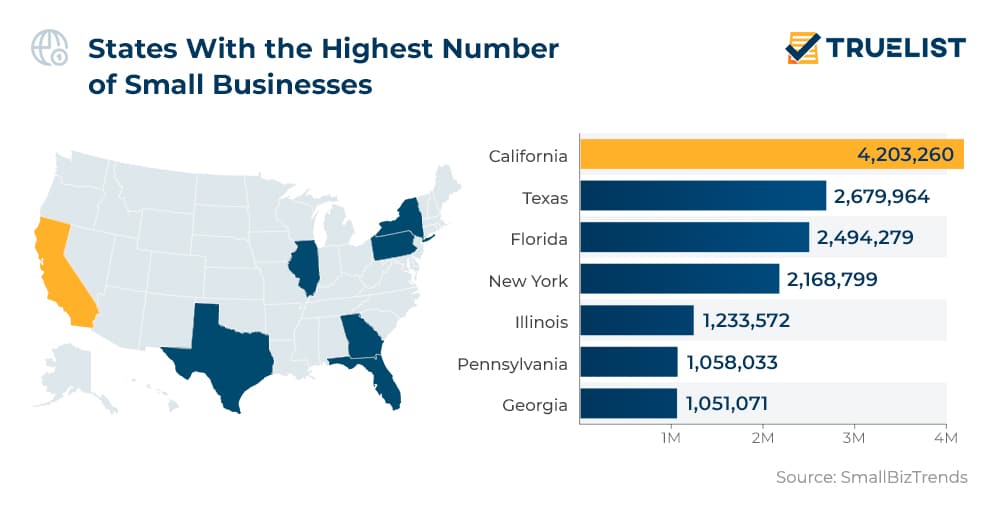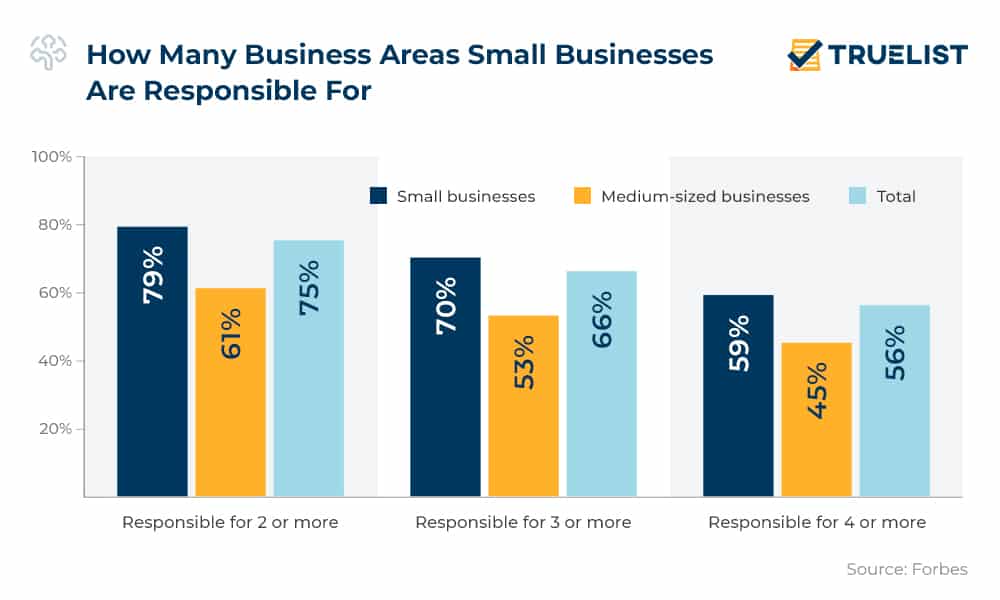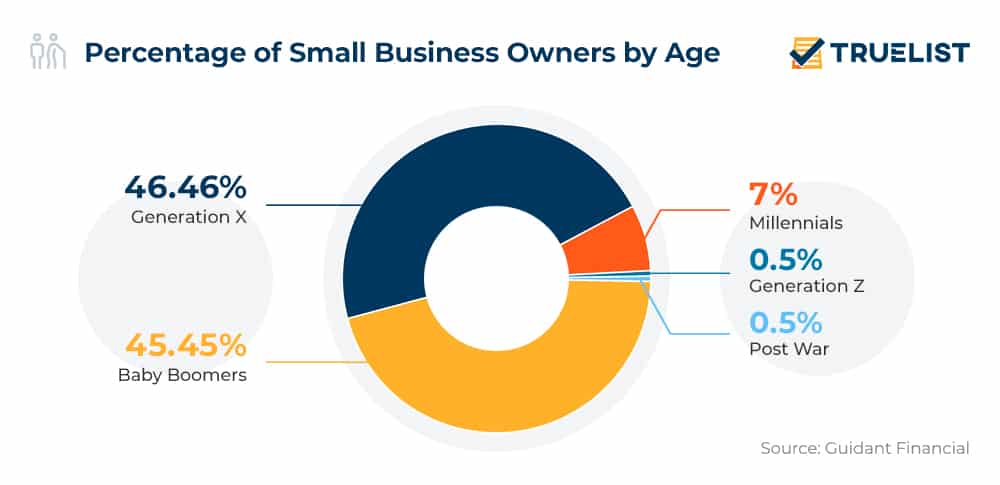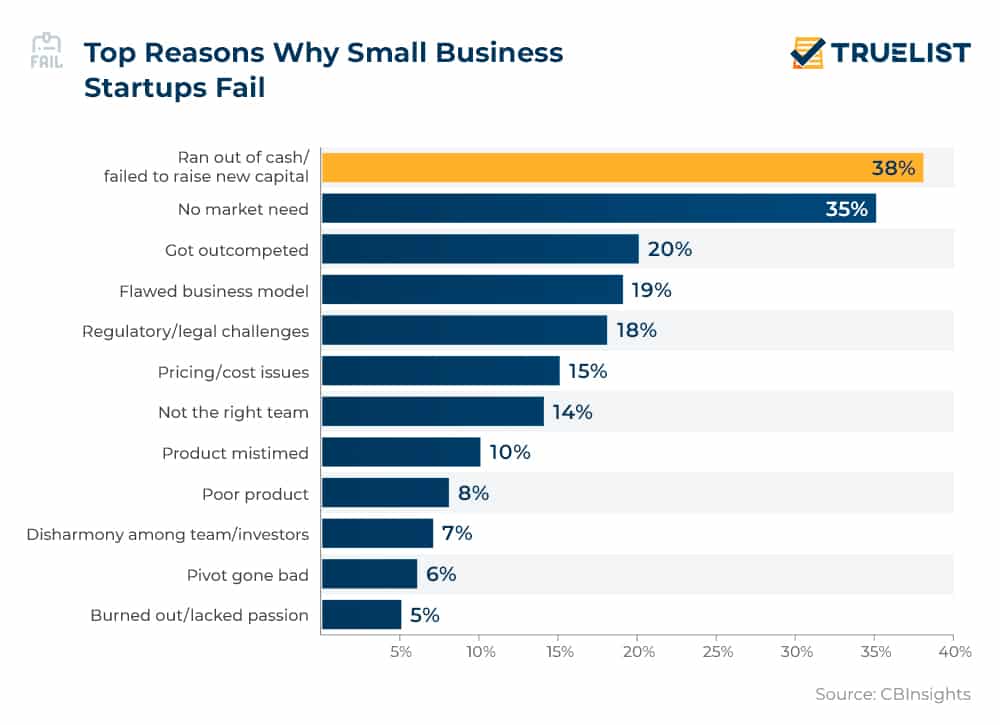Small businesses are considered the backbone of any economy, and rightfully so. They bring innovation to the market and also provide employment for those who have been rejected by big corporations. These small business statistics provide further insight into the market and can help entrepreneurs place their product or service for the best possible results.
Small Business Statistics (Editor’s Choice)
- There are approximately 25.1 million SMEs in the EU. (Statista)
- Small businesses account for 70% of global employment. (Finances Online)
- Over 50% of all small businesses are home-based. (SBA.gov)
- Nearly 9.9 million small businesses in America are owned by women. (American Express, Finances Online)
- 65.3% of small business owners claim their business is profitable. (Guidant Financial)
- Cash flow plays a major role in the failure of 82% of small businesses. (Fundera)
Small Business Stats Rundown
1. The number of small and medium-sized enterprises worldwide stands at 400 million.
Small businesses are the lead job creators and account for over 95% of firms and up to 70% of the global employment rate. Global small business statistics indicate these enterprises are vital to ensuring economic growth, innovation, and social integration. Many of them maintain close relations with their employees, business partners, and the local community, making them an irreplaceable part of the global supply chains.
(GlobalNaps)
2. US small business statistics show there are 32.5 million small ventures stateside.
Based on data from the Small Business Administration, the number of small businesses in the US is 32.5 million. Percentage-wise, they make up 99.9% of the whole business community. They are further considered key innovators in the US economy.
(Oberlo)
3. There are approximately 25.1 million SMEs in the EU.
Moving to the other side of the Atlantic, the most recent EU small business stats indicate that there are a little over 25 million small and medium-sized enterprises, the majority of which are micro-sized with fewer than nine employees. The EU market further boasts 1.47 million small firms with up to 49 employees and nearly 240.000 medium-sized enterprises with up to 249 employees. While the value that SMEs add to the European economy varies per country, the average stands at around 56%.
(Statista)
4. In the US, California leads the pack with 4,203,260 small businesses.
Back home, small business statistics by state point to California as the US state with the highest number of small businesses (99.8%) and a staggering 7,129,204 employees. Texas is ranked second with a total of 2,679,964 employing a solid 4,706,864 people. Ranked third, Florida fosters an incredible 2,494,279 small businesses employing 3,397,931 people. Overall, US small businesses employ nearly 60 million people.
(SmallBizTrends)

5. Cyber incidents are the leading concern for 39% of small businesses worldwide.
Small business cybersecurity statistics show that since 2018, when 30% of small enterprise companies were worried about the risks originating from cyber attacks, the number went up by 5% in 2019. Due to their inability to allocate sufficient funds for cyber protection, small businesses have traditionally been considered easy prey by hackers.
(Statista)
6. Small businesses account for 70% of global employment.
Worldwide, seven out of ten people are working for a micro or small business. Small business employment statistics further reveal that small businesses are building the GDP of more than half of developed countries.
(Finances Online)
7. Over 50% of all small businesses are home-based.
With the majority of US citizens having access to the internet, one cannot blame them for wanting to work from the comfort of their homes. This is the standard practice of many sole proprietorships since they don’t have to worry about finding and paying for office space. The percentage of home-operated firms without paid employees, as home-based business statistics indicate, amounts to 60.1%. Then, 23.3% are small employer businesses while 0.3% are large employer businesses.
(SBA.gov)
8. SMB employees spend 23% of their working days on manual tasks.
About two-thirds of small business owners (66%) take direct responsibility for three of the most significant aspects, such as operations, marketing, customer services, product development, sales, and finance. According to Forbes, 23% of employees spend their work time manually inserting data. For a sector that brings innovation to the table, this sounds a bit outdated, right? Small business entrepreneurs can minimize such unproductive methods by incorporating more digital tools or even hiring digital marketing agencies to outsource the tasks.
(Forbes)

9. You need just 4.2 days to start a business in the US.
It seems like starting a business stateside doesn’t take much time, especially when compared to Haiti’s 97 days or Bosnia and Herzegovina’s 80 days. In India, you need about half a month, while in the UK you’d need around 4.5 days. On the other hand, if you are in New Zealand you can get things done in a single day.
(Trading Economics)
Small Business Owner Demographic Statistics
10. Six out of ten people who start a small business are between 40 and 60 years old.
It’s never too late to follow your dreams and start a business from scratch. The demographics of small business owners reveal that a staggering 60% of people who start a small business are over 40. A recent survey of more than 2,500 small entrepreneurs in the US showed that small business ventures are not just popular among people up to 60, but 4% of small startups are owned by persons over 70.
(Markingblog)
11. Nearly 9.9 million small businesses in America are owned by women.
Small business statistics in an American Express report show that in 2019, the number of women-owned small businesses in the US rose by 21%, resulting in a 9% increase in all businesses. The latest reports on small business owner demographics disclose that women in the US own a little over a third of small enterprises or 9.9 million, as opposed to men who are in charge of 14.8 million ventures.
(American Express, Finances Online)
12. US women-operated businesses are less likely to receive external financing.
Small business owners statistics show that women-owned ventures make $50,000 revenue in their first year, compared to $75,000 for men-owned counterparts. In the second year, the revenues of both increased by $59,000 and $91,000, respectively. Small business revenue reports also show that in the next two years, men increase the percentage of their income by around 30% ($100k and $105k), yet women-owned businesses grow by just a couple of percent ($65k and $68k).
(SmallBizTrends)
13. 46.46% of small business owners are Gen Xers.
Small business owners statistics show that Gen Xers hold the bulk (46.46) of the small biz market. This marks a small lead over Baby Boomers who comprise 45.5% of small business owners. Millennials hold third place with 7%.
(Guidant Financial)

14. Men are two times more likely to start a new business than women.
A recent report points to some fascinating small business owner demographics; men are twice as likely to become entrepreneurs than women. Women are 81% less confident than men that they can access the appropriate start-up funds and what is more fascinating is that their estimates on funding are usually 40% lower compared to men’s. Additionally, when women start a business, it tends to be smaller in size i.e. on average they start out with 53% less capital than men.
(InstantOffices)
Small Business Growth Statistics
15. Digital tools have helped over 40% of all SMBs grow their customer base in 2019.
Small and medium businesses experienced a growth of over 40% in their customer base in 2019. Stats show that small businesses that have successfully integrated digital tools in their everyday work are more likely to report increased numbers of customers than their peers. These enterprises further report a 5X higher probability of reaching international customers.
(Deloitte)
16. 65.3% of small business owners claim their business is profitable.
Small business growth statistics mention that the leading three priorities for business owners this year are increasing staff (51.04%), remodeling or expanding business (41.02%), and investing more in digital marketing (39.70%). Also, aspiring businesses should prioritize securing reliable staff, investment in digital marketing, along with a competitive customer experience.
(Guidant Financial)
17. Six out of ten small businesses are organic or financed growth firms.
JPMorgan’s small business revenue statistics further show that small ventures take the most significant risk; 31% of organic growth and 20% of financed growth companies do not make it past their fourth year. Many small businesses generate their revenue through collaborations with other SBMs which is a perfectly healthy way to grow a business, and recent reports on the success rate of small businesses confirm financing is not the only way to expand a firm. More than 50% of small companies belong to the organic growth type and generate profit mostly from conducting business with other small businesses.
(JPMorgan)
Small Business Failure Statistics
18. 50% of all small businesses live up to five years or more.
Discussing the small business failure rate (or success rate for that matter) is tricky. Some businesses, small or big, are born successful while others struggle to find their place in the ecosystem. The good news is that a little over 60% of small businesses survive their first two years, and 50% will manage to survive the first five. About one-third are the ultimate survivors and manage to endure up to ten years or more.
(Fundera)
19. Cash flow plays a major role in the failure of 82% of small businesses.
Small business failure statistics confirm that a massive 82% of business owners report cash flow as a decisive factor in their operations and in many cases, as the main reason for their failure. Many businesses do not just experience problems with money coming in and out, but they also locate the problem with the invoicing. On many occasions the invoices are paid after the loan payment is due, hence the money flow problem. Seasonal businesses usually suffer the most.
(Fundera)
20. One in 12 businesses closes each year.
According to small business bankruptcies statistics, the short answer is that one in 12 enterprises goes under each year. The long answer is that 20% of all new small businesses don’t make it past the first year of working, and the number increases in the fifth year.
(BLS.GOV)
21. The COVID-19 pandemic made 31% of US small businesses non-operational.
The uncertainty caused by the coronavirus crisis was a heavy blow for small businesses in the US, and over 70% of them were forced to shut down in March. According to small business statistics, COVID also caused 60% of SBs to close down following orders from health authorities. The good news is that some managed to adapt to the new situation and started selling their products and services online, with 51% enjoying a rise in online interactions with their clients.
(Oberlo)
22. Running out of cash or failure to raise new capital is the biggest reason why SB startups fail.
CBInsights’ data reveals that the biggest reason for the high percentage of small businesses that fail (38%) is running out of cash or failing in raising new capital. Also, 35% fail because they offer a product or service that consumers don’t need. If you want to succeed in the competitive market, you must offer something that people want, not what you think they need.
(CBInsights)

Small Business Lending Statistics
23. Institutions approved 65.9% of small businesses’ loan requests in 2019.
The number of small businesses in the US that sought external funding is moderate. Statista’s data shows the majority of loan requests that were approved (65.9%) were institutional, while 56.5% were with alternative lenders. Experience shows that small businesses usually take loans so they can pay the operational costs until they reach a point where they can generate enough revenue to cover those expenses.
(Statista)
24. The inability to obtain finances is an issue for 27% of businesses.
Small business statistics about financing reveal that almost one-third of businesses were unable to receive the funding they needed to develop their business. One in four businesses says that they couldn’t meet their business or finance goals because of financial issues. And many of these enterprises experienced the worst-case scenario by being forced to lay off employees.
(Fundera)
25. Online lenders have the highest loan approval rates at 82%.
Online lenders are growing in popularity among business owners and the demand continues to grow. Small business lending statistics confirm approximately 32% of companies applied for an online loan in 2018, marking an 8% YoY rise. Even though online lenders have the lowest satisfaction levels, it appears many businesses still turn to them. The high approval rates could be the reason for this, as online lenders have an 82% approval rate compared to the 71% approval rate of small banks.
(Fed Small Business)
26. The approval rate of small business loans in large banks was 28% in 2019.
According to an October 2019 report, large banks reached 28% of the approval loan rate. Forbes further reports that the whole year was excellent for small businesses that benefited from the positive economic conditions in the US at the time.
(Forbes)
FAQ
What percentage of small businesses are profitable?
Small business success rate and profitability data indicate 40% of these enterprises are profitable. And this is a good number given the constant market uncertainty. Stats further show that around 30% are balancing the scales on a daily basis, while another 30% are constantly losing money. Research also shows that two founders succeed better than one because they can get 30% more money and are almost 20% less likely to scale prematurely.
(Small Biz Trends)
How many employees is considered a small business?
Up to five hundred employees and less than $7 million in sales is what classifies as a small business. For the US Small Business Administration, on the other hand, small businesses are companies with up to $35.5 million in sales and a total of 1,500 employees.
(Yelp)
How many employees work for a small business?
A small business typically employs less than 500 people. And although numbers vary across the world, a staff of ten or fewer is what one would expect to find at a micro or small business.
(Oberlo)
How many new businesses start each year?
An incredible 627,000 businesses open in the US every year. Given the strong performance of the US economy and the high rating issued by the World Bank and the fact that much of the workforce is employed by SBs, the numbers should come as no surprise.
(Small Business)
What are the most common small businesses?
Sole Proprietorships are the most common forms of business in the US, these days, as they are the simplest to operate. A sole proprietorship is an unincorporated business owned by one person.
(Camino Financial)
Conclusion
There are various factors that can hurt your business during its first five years of operation and even send you under. That said, these small business statistics show that with the right strategy and product or service, along with carefully secured funding, you might just be among the lucky ones that do make it.
Sources: GlobalNaps, Oberlo, Statista, SmallBizTrends, Statista, Finances Online, SBA.gov, Forbes, Trading Economics, Markingblog, American Express, SmallBizTrends, Guidant Financial, InstantOffices, Deloitte, JPMorgan, Fundera, BLS.GOV, CBInsights, Statista, Fed Small Business, Forbes, Small Biz Trends, Yelp, Oberlo, Small Business, Camino Financial

